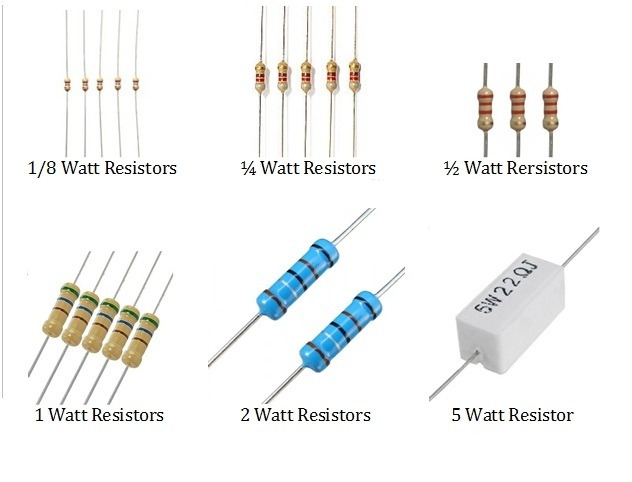Resistors are used for many applications in a circuit. But all resistors are not suitable for all the applications. Resistors are selected using different parameters.
Resistor color codes helps to read resistance, tolerance and voltage. Other than these three values, there is another important parameter required, for using the resistor in a circuit. This is power rating of a resistor.It is very important to use correct power rated resistor in the circuit to prevent the circuit from damaging.
Outline
ToggleWhat is the meaning of power rating?
- Resistor power rating can be defined as the maximum power a resistor can handle safely without any damage.
- We know that, resistor dissipates the excess energy in form of heat. Power rating indicates the maximum heat a resistor can dissipate safely.
- Increasing the power more for few percent than rating, will burn the resistor.
How resistors are rated?
- The resistor power rating is rated in watts, which are units of power. Hence it is also termed as wattage.
- Generally, larger the resistor more power it can handle.
- As the wattage of the resistor increases cost also increases.
- Resistors generally start from 1/8th watt to many kilo watts.Resistor wattage can be noticed by seeing the size of the resistor.
Resistors with high wattage are called power resistors. Below is the figure showing resistors with their wattage.
How to determine wattage of a resistor?
Electrical power is given as P=V x I
Where v is voltage
I is current
From Ohm’s Law, we have V = I × R
Where R is resistance
Therefore P = I2 × R
And P = V2 / R
Hence the power dissipation in a resistor can be calculated using any of the following standard equations
- Power P = V × I
- P = I2 × R
- P = V2 / R
Here is example to calculate the resistor rating to be used in a circuit.
Consider a circuit powering a led with a source voltage of 12v and resistance of 800 ohms. Now calculate what wattage resistor can be used in the circuit?
We know V= 12v ,R=800 ohms.Now calculating the current
I=V/R=12/800 = 0.015=15 mA current.
Thus power dissipated by the resistor is calculated using P= 12x15x10-3 =0.18 watts
Hence a 1/4th watt resistor must be used here. Using 1/8th watt resistor will damage the circuit.
Power Resistors
- Resistors that are designed to handle high power are called power resistors.
- Resistors with power rating of at least 5W come under power resistors.
- The material used for construction of power resistors must be of high thermal conductive in nature.
- Power resistors often come with heat sink which helps them in dissipation of heat.
Wire wound power resistors
- Wire wound power resistors are common, but they can also be found in other types.
- If Nichrome alloy based wire wound resistors are used with proper non-conductive enamel paint, they can withstand temperatures up to 4500C.
Grid Resistors
- Grid Resistors are used to withstand large amounts of currents .
- They can withstand a current up to 500 Amps and can have a resistance values as low as 0.04 Ω.
- The construction of Grid Resistors includes two electrodes with large metal stripes connected between them in the form of a matrix.
- Grid resistors are used as grounding resistors, brake resistors and harmonic filters for electric substations.
Water Resistors
- The construction includes tubes which carry saline solution with electrodes connected at both ends of the tube.
- The concentration of saline solution or salt water will determine the resistance.
- Because of the presence of water in the tubes, water resistors provide large heat capacity, which in turn result in high power dissipation.
SMD Power Resistors
Power resistors can also be made in the form of Surface Mounted Devices.
Because of their small size, the power dissipation capacity of SMD resistors is less than grid type resistors and water resistors.
Usually the power dissipated by SMD resistors is in the order of few Watts.
The range of power dissipated by different types of power resistors are as follows
- SMD Resistors 5 W or less
- Helical Wound 50 W or less
- Edge Wound 3.5 KW or less
- Grid Resistors 100 KW or less
- Water Resistors 500 KW or less
Applications of Power Resistors
Power resistors are used in applications where we need to dissipate large power. Some of the applications of Power resistors are
- Engine brakes in heavy locomotives and trams use power resistors. Locomotives move at high speed and possess high kinetic energy. While stopping these high speed locomotives, their kinetic energy is converted to heat.
Depending on the velocity of the locomotives, the amount of heat generated can be in the order of few Kilo Watts. Classic disc brakes can’t be used as they wear out easily. Hence regenerative brakes or high power resistors in the form of Grid resistors are used in locomotives. - Power resistors are used as grounding resistors to limit fault currents, high voltages and act as protective relays. These resistors can be rated up to 8 Kilo Amps.
- Power resistors are used as load resistors in turbines and Uninterruptible Power Supplies. They can be designed to provide adjustable resistance and can dissipate a power of up to 6 Mega Watts. Because of this high power dissipation, load resistors are equipped with an efficient cooling system to control the temperature and prevent the devices from burning out.



One Response
Its good basic knowledge od risister